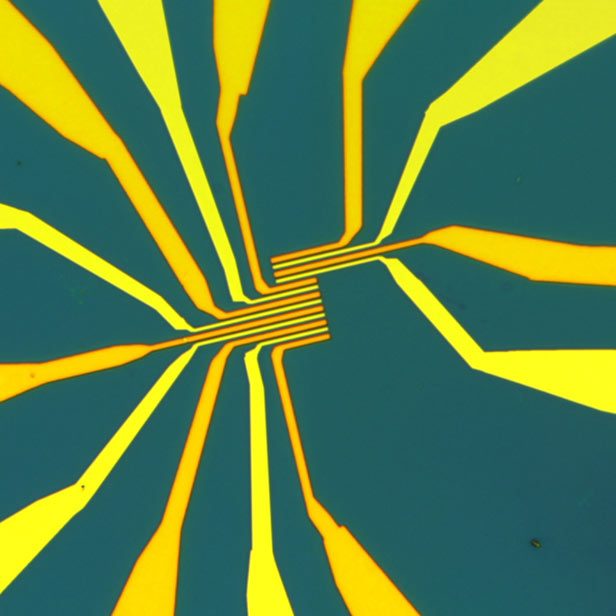Graphene Competitor Used to Make Circuits

The first logic circuits made using atom-thick sheets of a material called molybdenite suggest a possible new solution to the problem of getting more power out of silicon computer components.
It also establishes molybdenite as a competitor to graphene, the atom-thick sheets of carbon believed capable of solving silicon’s shortcomings, and whose creators received a Nobel prize in 2010.
Silicon technology is in trouble because, for years, performance has been improved by shrinking the size of the features on silicon chips, but there is only so much more shrinking that can be done. Chips will go on sale this year with features as small as 22 nanometers, and at very small scales, silicon technology faces problems like oxidation, which reduces performance and causes energy losses.
Molybdenite, or MoS2, could allow electronics to get smaller still without such problems, says Andras Kis, who led a team at the Swiss Federal Institute of Technology in Lausanne, Switzerland, to make the first integrated logic circuits, the basis of computer chips, using molybdenite sheets.
Sheets of the material 0.65 nanometers thick and roughly 10 microns across were pulled from crystals of naturally occurring molybdenite. The sheets were made into transistors by laying them onto a silicon wafer and adding gold electrical connections. The linked up transistors functioned as logic gates, the basis of digital computing components.
Researchers seeking alternatives to silicon have been working with graphene for years, making, for example, prototype transistors that operate at much higher speeds than silicon ones. However, molybdenite has a crucial advantage, says Kis. “The nice thing about our material is that sometimes it can conduct current, sometimes it doesn’t.”
To do the job of silicon in electronics, a material needs to be able to flip between conducting and nonconducting to signal digital 1s and 0s, something made possible by an electronic property known as a “band gap.” Molybdenite naturally has a band gap suitable for use in electronics, while graphene does not. Giving graphene a band gap involves complex techniques like layering sheets of the material, cooling it to low temperatures, or cutting it into very precise shapes.
“Everyone was saying ‘graphene, graphene, graphene,’ so we thought, let’s look at something slightly different,” Kis says. “There’s a lot more attention on MoS2 now.” Although his team used naturally occurring molybdenite, it can be easily made by reacting sulfur with the metal molybdenum, widely used in the steel industry.
James Hone at Columbia University studies graphene and also molybdenite. He says that the Swiss team did well to find a way to allow electrons to flow freely from gold electrodes into the molybdenite, since the two materials don’t naturally make a good connection. Kis’s team solved the problem by adding hafnium oxide “gates” that function as electrical on-ramps between the gold terminals and molybdenite.
The Swiss team has established a new performance benchmark for molybdenite, Hone says. “We’re starting to see that the fun is going to come with mixing and matching these 2-D materials on different substrates for different functionality,” he says. “A lot of people are interested now; progress is happening so fast.”
However, despite molybdenite looking like a promising avenue to explore, the multibillion-dollar silicon industry isn’t at risk of disappearing anytime soon, says Kis. “There are still many questions, like how to grow this on a large scale,” he says. “People really know everything there is to know [about silicon]. There’s a lot of exploring still to be done with molybdenite.”
Keep Reading
Most Popular
Large language models can do jaw-dropping things. But nobody knows exactly why.
And that's a problem. Figuring it out is one of the biggest scientific puzzles of our time and a crucial step towards controlling more powerful future models.
The problem with plug-in hybrids? Their drivers.
Plug-in hybrids are often sold as a transition to EVs, but new data from Europe shows we’re still underestimating the emissions they produce.
Google DeepMind’s new generative model makes Super Mario–like games from scratch
Genie learns how to control games by watching hours and hours of video. It could help train next-gen robots too.
How scientists traced a mysterious covid case back to six toilets
When wastewater surveillance turns into a hunt for a single infected individual, the ethics get tricky.
Stay connected
Get the latest updates from
MIT Technology Review
Discover special offers, top stories, upcoming events, and more.